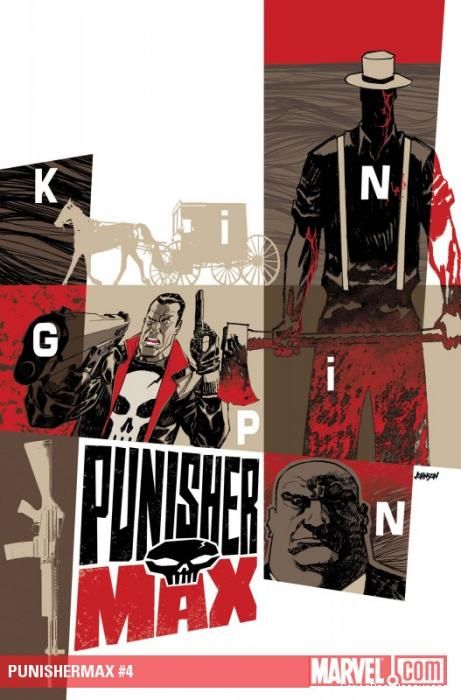This isn't a fast-paced series, and yet within the first four issues we've seen the Kingpin's rise to power and the introduction of a major new threat to Frank Castle's well-being. But between Steve Dillon's open-panel art style, and Jason Aaron's sparse use of dialogue, this series doesn't feel like it's moving all that quickly. The pacing feels right, though. It feels like a slow burn, and it creates tension on nearly every page.
Here, the Mennonite strikes at the Punisher, and Wilson Fisk goes all Michael Corleone on the gangland leaders. The Mennonite could have been played as a joke villain -- as some kind of Weird Al parody of a supervillain, one whose abhorrence of technology is his own kind of secret weapon -- but Aaron and Dillon make him terrifying in his simplicity. It's a shrewd way to provide a threat for Frank Castle, since just another hitman with a gun would have seemed like nothing new. But a guy with a horse and buggy? Using a sledgehammer and an axe? That's hardcore, and even if it sounds silly, it doesn't look so silly when he's smashing the Punishers ribs or trampling his skull.
Aaron and Dillon make the Kingpin terrifying as well, showing him not only pull the strings to eliminate his enemies but actually spill their blood on his own clothes when necessary. And "when necessary," in the Kingpin's case, means, "when necessary to provide symbolic effect." Because Aaron's version of the Kingpin, the Kingpin Max, is a man who understands the power of symbolism. The Kingpin, as a concept, existed before he chose to step into the role, and he realizes what it takes to get himself there. Most versions of Kingpin present him as a physical force, or as a man who uses his influence to ruin lives. But Aaron portrays him as a man who knows how to take advantage of a situation. As a man who thinks strategically, and acts without remorse.
With Steve Dillon's art, "Punishermax" occupies a strange place in Punisher history. Dillon makes it look like the more absurdist of the Garth Ennis Marvel Knights Punisher talesx, or his art reminds us of those stories because he drew most of those as well. And this isn't exactly the black ops, heavy voice-over version of Punisher Max that we saw from Ennis, either. This series is somewhere in between. The Mennonite is an absurdist concept, played without the kind of exaggeration Ennis might have used, and the stories unfold methodically, precisely, not with the manic energy or the bundled excess of any previous Ennis Punisher stories.
In other words, its Jason Aaron's version. His mark on the character. And like Steve Dillon, he has his own dirty, elegant, ugly, beautiful simplicity.

